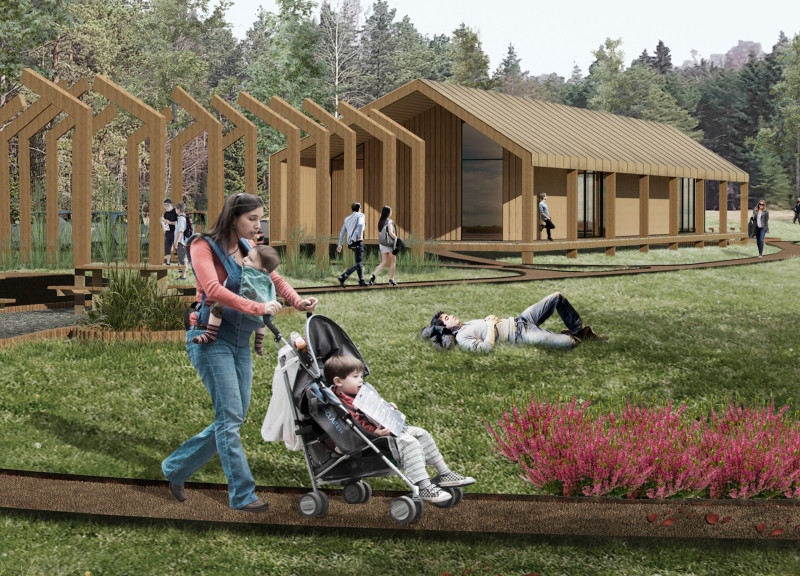5 key facts about this project
The design approach is rooted in a concept that prioritizes harmony with the surrounding landscape. The architecture features an organic wooden structure that draws inspiration from traditional Latvian building techniques. This connection to cultural heritage not only adds aesthetic value but also reinforces the building's contextual relevance. The selection of natural wood for the primary structural elements fosters a warm and inviting atmosphere, emphasizing the architecture's relationship with the forest environment.
Functionally, the visitor center accommodates a variety of activities, such as educational programs, interactive exhibits, and community gatherings. The layout promotes a smooth circulation pattern, guiding visitors through different areas of the center while encouraging exploration of both the building and the surrounding landscape. This careful organization enhances the overall visitor experience, allowing guests to interact freely with educational materials and resources about the bog's flora and fauna.
The integration of flexible spaces within the visitor center is a noteworthy characteristic of the design. These spaces can be adapted for various uses, from lectures to workshops, showcasing a versatile approach that meets diverse public needs. The architectural design incorporates expansive glass panels that facilitate natural light and visually connect the indoor environment with the outside views of the bog. This deliberate design choice not only promotes energy efficiency but also immerses visitors in the beauty of the natural surroundings.
Unique design approaches are evident throughout the project. For instance, the use of varied rooflines and the incorporation of landscaping elements help to mimic the gentle undulations of the bog terrain. The building's footprint is slightly elevated, which contributes to a floating appearance that minimizes site impact while allowing for unobstructed views over the natural landscape. This elevation also creates opportunities for visitors to engage with the ecosystem, enhancing the overall educational experience.
Materials play a crucial role in this project, with a focus on sustainability and a minimal ecological footprint. The use of natural wooden beams and cladding maintains a connection to local materials, while the glass is chosen for its efficiency and its ability to draw in light. The landscaping strategy utilizes native plant species to support local wildlife and create a seamless transition between the building and the surrounding environment. Native vegetation enhances biodiversity and exemplifies sustainable practices in landscape architecture.
In addition to the architectural details, the project promotes an ethos of environmental stewardship. By educating visitors about the importance of wetland ecosystems, it instills a sense of responsibility towards conservation and habitat preservation. The visitor center serves not only as a place of learning but also as a catalyst for environmental awareness, inspiring visitors to engage actively with the landscape.
The Kemeri Bog Visitor Center reflects a comprehensive understanding of how architecture can influence visitor experience while maintaining respect for nature. The careful balance of functionality, aesthetic appeal, and ecological sensitivity positions this project as a model for future designs that aim to celebrate natural landscapes. Readers interested in a deeper exploration of the project are encouraged to examine the architectural plans, sections, designs, and ideas presented, which provide further insights into this well-conceived architectural endeavor. By delving into the specifics of the design, one can appreciate the meticulous thought that has gone into creating a space that enhances public interaction with one of Latvia’s unique natural treasures.


























